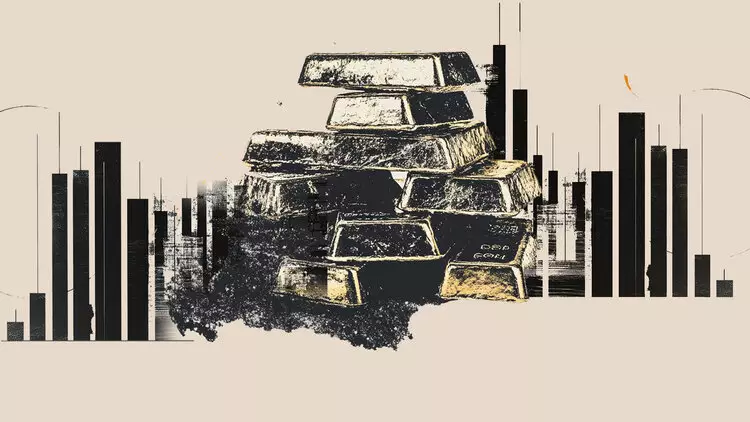In a remarkable display of market resilience, gold prices recently soared to an unprecedented peak, touching the $3,703 mark—its highest level in recorded history. Although subsequent trading saw a slight retreat to approximately $3,687, the metal remains perilously close to this all-time high, signaling a robust bullish trend. This rally underscores a confluence of factors that reinforce gold’s status as a premier safe-haven asset and a preferred hedge amid economic uncertainties. The dynamics at play suggest that investors are increasingly leaning towards gold not merely as a refuge but as a strategic asset that benefits from the current macroeconomic environment.
The relentless upward movement is underpinned by a weakening US dollar and subdued Treasury yields. These conditions reduce the opportunity cost of holding non-yielding assets such as gold, incentivizing investors to diversify into precious metals while global monetary policy signals hint at easing. With the Federal Reserve poised to cut interest rates by 25 basis points this week, market participants are eager to interpret the Fed’s economic outlook, which is likely to dictate the short-term trajectory of gold prices. The steadfast anticipation of a rate cut, coupled with a weakening dollar, creates a fertile ground for gold to maintain its bull run, challenging previous resistance levels and establishing new psychological benchmarks.
US Monetary Policy and Its Impact: The Market’s Balancing Act
A critical facet of the gold rally stems from the broader monetary policy landscape. The Federal Reserve’s anticipated rate reduction is casting a long shadow over the dollar and bond yields. With US Treasury yields remaining tepid, the comparative attractiveness of gold intensifies. The zero-yield nature of the metal no longer acts as an obstacle but instead benefits from the relative decline in the US dollar and weakening bond returns.
However, the market’s direction still hinges on the Fed’s messaging. Investors are scrutinizing Fed Chair Jerome Powell’s upcoming press conference and updated economic projections—including the widely watched dot plot—to glean clarity on the central bank’s future plans for policy easing. A dovish or overly cautious tone could bolster bullion’s appeal, pushing prices beyond the psychological $3,700 barrier and potentially towards $3,750 or higher. Conversely, a less accommodating stance might trigger short-term profit-taking, prompting a modest retreat. Nonetheless, the market’s current outlook indicates a predisposition towards continued dovishness, with economic data such as robust consumer spending further bolstering the case for sustained easing.
The recent surge in US retail sales—rising by 0.6% in August—has been a significant underpinning of this optimistic outlook. Such data ease fears of an impending recession and reinforce the narrative that the economy remains resilient despite political and geopolitical uncertainties. This resilience, paradoxically, supports gold’s gains; investors feel less compelled to seek safety from economic downturns and more inclined to hedge against prolonged monetary easing and currency fluctuations.
The Technical Landscape: Navigating Resistance and Support
From a technical perspective, gold’s recent price action demonstrates both strength and cautious overbought conditions. The market broke through the $3,650 resistance on Monday, implying that bullish momentum remains intact. Currently trading near $3,695, just shy of the critical $3,700 psychological threshold, chart indicators like the Relative Strength Index (RSI) at 73 suggest that the metal is overbought but not without room for a short-term extension.
The MACD indicator has turned bullish, with its line crossing above the signal line and green bars expanding, reinforcing the case for further upside. Key support levels are identified around $3,675—the previous high—and the 21-period simple moving average near $3,652. A slip below these levels might expose the next support zone at approximately $3,620, where buyers could step in once again, restraining a deeper correction.
On the upside, for gold to make a decisive breakout beyond $3,700, sustained momentum will be crucial. If achieved, traders might see an advance toward the $3,730-$3,750 range, driven by continued dollar weakness and easing expectations. The current sentiment exemplifies a classic risk-on environment with a tilt toward precious metals, driven by macroeconomic data and Fed’s policy stance. For investors and traders alike, vigilance around these technical levels will be essential, as volatility can spike rapidly around such pivotal psychological thresholds.
Market Sentiment and Broader Currency Dynamics
Parallel to gold’s ascent, the US dollar has experienced notable weakness across major currency pairs, with the US dollar index (DXY) falling to multi-week lows. This broad-based decline in the dollar reflects market expectations of continued easing by the Fed and a cautious global sentiment concerning economic growth prospects. Among major currencies, the USD has weakened most sharply against the New Zealand Dollar, indicating a preference for risk assets and a possible shift in global capital flows.
This currency dynamic is not isolated but part of a larger narrative whereby declining dollar strength propels gold higher, especially when paired with subdued yields and dovish policy signals. Market participants are aware that currency fluctuations will play a fundamental role in shaping the gold market’s trajectory in the coming weeks. A sustained weak dollar environment could serve to reinforce gold’s upward momentum, embedding it further into multi-decade highs.
Ultimately, the combination of dovish monetary policy signals, resilient economic indicators, and currency weakness paints a compelling picture for gold’s continued ascent. While near-term corrections are inevitable given overbought conditions, the medium-term outlook remains bullish—championed by the market’s collective inclination toward risk hedging and monetary easing. Gold is more than just a shiny metal; it’s the tangible evidence of a world grappling with economic uncertainty, recalibrating expectations, and seeking stability amidst turbulent times.

